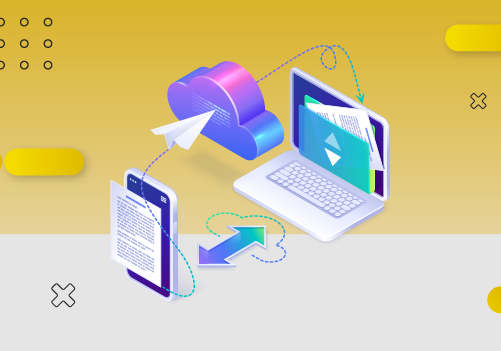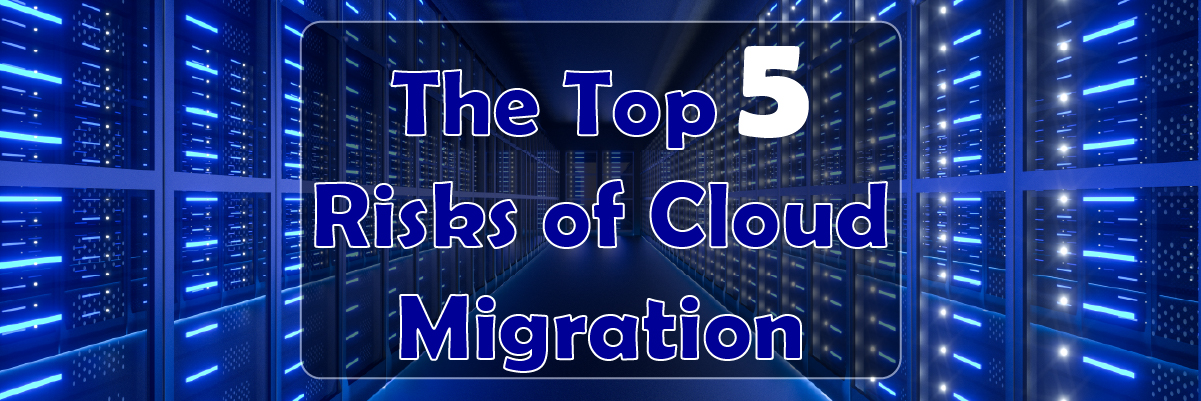The Top 5 Risks of Cloud Migration
When it comes to cloud migration, there are plenty of risks involved. Every business considering migrating its IT infrastructure from a traditional data center to a public cloud must identify potential obstacles. After all, it’s not an easy transition, even with the many tools and resources available. A study by New Voice Media found that only 14 percent of companies that had begun transitioning to the cloud environment completed the process successfully. This means businesses have plenty of opportunities to get things right the first time. With so much information available about how and why companies should migrate their IT infrastructure to the cloud, it’s essential to understand which risks need addressing first.
When deciding about cloud migration services, one of the first things to remember is the risk involved with the process. There are many different types of risk, ranging from financial to technical. In this blog, we’ll learn the top 5 risks of cloud migration and how to mitigate them.
Cloud Migration is Only the Beginning
Cloud migration is the process of moving applications, data, and other business elements from on-premises infrastructure to the cloud. When companies approach the decision for cloud adoption, they often think it will solve all of their problems. The most significant risk is that businesses assume they can put off addressing the issues they face today by migrating tomorrow. In reality, migration is only the beginning of a new set of challenges that businesses must overcome to ensure their data remains safe and secure in the long term. If a company has a poor security system today, it will have a flawed one tomorrow, regardless of whether the data is hosted on-premises or in the cloud. This is why migration should be seen as a way to improve the business environment rather than just a quick fix to a single issue.
There are four main types of cloud migration: Lift and Shift, Replatforming, Refactoring, and Rearchitecting. These four types of cloud migration offer businesses different levels of transformation and complexity, providing options to choose the most suitable approach for their needs.
Why is Security in the Cloud a Challenge?
Migration to the cloud should be considered a long-term investment, not a short-term solution. However, the fact that most organizations are new to the cloud platform makes it difficult for them to know what to expect. Often, businesses don’t fully understand the risk associated with, and the potential impact cloud migration could have on their business. Of course, security is the biggest challenge of all. Public cloud data centers are designed for maximum scalability and flexibility, so companies don’t have the same level of control and visibility as they do with their own data centers. Even if a business uses a managed cloud provider or hybrid clouds, it still has to ensure it applies the proper security measures to keep its data safe.
To mitigate the risks associated with cloud migration, developing a comprehensive cloud migration plan and carefully choosing a reliable cloud migration service provider is crucial.
 Data Theft Causes Unauthorized Access
Data Theft Causes Unauthorized Access
Data theft is a common problem with traditional infrastructure. If a company fails to protect its application and data, unauthorized access is always a risk. Businesses are no longer in control when that data is migrated to the cloud. When migrating to the cloud, companies often store their data in a third-party facility or premises data center. This creates a single point of failure; hackers will have access to all the data if they breach security. This can include all types of information, including personally identifiable and sensitive client information. If this data is stolen and isn’t encrypted, it can be used for malicious purposes, including identity theft and financial fraud. The potential economic impact on a business can be huge.
How to avoid it?
- Encryption: Implement strong encryption methods for data in transit and at rest. This ensures that even if unauthorized access occurs, the stolen data remains unreadable.
- Access Control: Utilize robust access control mechanisms to limit and monitor who can access sensitive data. Implement multi-factor authentication for an added layer of security.
Third-Party Product Comes with Security Risks
Third-party products are needed in every aspect of the business. However, they present certain security risks. For example, a third-party VPN device could be easy for hackers to compromise. When migrating to the cloud, it is crucial to understand the security level of third-party products and services. Businesses must make sure the service provider uses a secure VPN connection when outsourcing. They should also consider hiring a third-party provider with a secure data center.
How to avoid it?
- Vendor Assessment: Conduct thorough security assessments of third-party products and services before integrating them into your cloud environment. Ensure that vendors adhere to industry-standard security practices.
- Continuous Monitoring: Regularly monitor and update third-party products to address any vulnerabilities promptly.
Hackers Can Compromise Vulnerable VPN Devices
Virtual private networks, or VPNs, provide a secure connection that keeps your internet data hidden from hackers and enables companies to safeguard their private cloud resources. Many cloud apps require a VPN to transport data from on-premises systems to the cloud. Although they are often bidirectional, VPNs are set up to only work in one direction. This frequently exposes your business to a cloud service provider attack. When hackers break into a VPN device, they can access the data transmitted between a remote user and the data center. This can result in data loss, stolen information, and financial losses.
How to avoid it?
- VPN Security Best Practices: Implement best practices for VPN security, such as regular updates, strong encryption protocols, and multi-factor authentication.
- Network Segmentation: Employ network segmentation to isolate critical components and minimize the impact of a potential breach.
Accidental Exposure of User Credentials
Cybercriminals typically use cloud apps as a cover in their phishing assaults. Due to the widespread usage of cloud-based communications and document-sharing services, employees are used to getting emails with links requesting them to validate their credentials before accessing a particular site or document.
Businesses often collect user credentials on the premises, such as passwords and usernames. However, when these credentials are migrated to the cloud, they are stored the same way as the other data. If hackers can access this information, it can result in a severe security breach. If the credentials are stored in plain text, hackers will be able to see them. This is one of the most common ways for hackers to access secure data. A fast and secure migration process involves encrypting the user credentials. However, some companies don’t make this a priority.
How to avoid it?
- Education and Training: Provide ongoing cybersecurity education and training for employees to recognize phishing attempts and avoid falling victim to credential theft.
- Multi-Factor Authentication (MFA): Enforce MFA to add an extra layer of protection, even if user credentials are compromised.
Lack of Secure API
An API is essential for connecting different business components, including CRM, application migration, and billing systems. If a company doesn’t put security at the forefront when designing its API, it can pose a significant risk to the business. When creating an API or a cloud native app, it is crucial to understand the security requirements. This includes authentication, authorization, and session management. If a company overlooks any of these requirements, it can result in a severe breach of security. Hackers can access sensitive data in the cloud if the API is easy to compromise. The Facebook-Cambridge Analytical Scandal, which gave Cambridge Analytica access to user data, is the most common example of an insecure API.
How to avoid it?
- API Security Guidelines: Follow industry best practices and guidelines for designing secure APIs. This includes proper authentication, authorization, and encryption of data transmitted via APIs.
- Regular Audits: Conduct regular security audits and assessments of APIs to identify and address vulnerabilities proactively.
Conclusion
By incorporating these strategies into your cloud migration plan and partnering with a reliable cloud migration service provider, you can significantly reduce the cloud migration challenges. Regularly reassess and update your security measures to adapt to evolving threats and technology advancements.
Moving to the cloud platform can be your business’s best action. Before going further, be sure you have a clear cloud migration strategy and are aware of the dangers associated with potential incompatibilities with the current architecture, security threats, and reduced visibility and control. Additionally, make every effort to prevent data loss, incomplete data deletion, excessive spending, and additional latency. Cloud migration plan might benefit your company if you can avoid these problems.
If you are considering moving your business to the cloud, you might have concerns about data security and the potential for downtime that could impact your customers. With Protected Harbor, you can rest assured that your data will be secure and available whenever needed while we create a tailored migration plan. Our engineers are certified by every primary cloud provider, and our team members are dedicated to your business’s success. We are rated as one of the top cloud computing companies in the US by Goodfirms.
With our help, you can start enjoying the benefits of the cloud sooner rather than later. Contact our cloud migration expert today.






